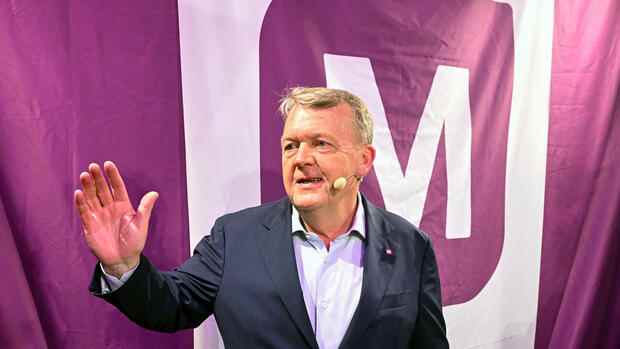The liberal politician founded his own party, The Moderates.
(Photo: Reuters)
In the parliamentary elections in Denmark, neither of the two political blocks is likely to have achieved its own majority. According to initial projections, Prime Minister Mette Frederiksen’s Social Democrats will again be the strongest party, but this time their left-wing camp is likely to miss out on a parliamentary majority.
If the trend is confirmed during the night on Wednesday, then former Prime Minister Lars Løkke Rasmussen will play a key role in the political center – and the time of two clearly separated blocs could soon come to an end for the northern German neighbor.
Løkke left the party in 2021 after decades with the liberal-conservative Venstre and several years as prime minister. He then founded a new party called Die Moderaten, which, according to broadcaster DR, received around 9 percent of the vote when it debuted. Venstre, on the other hand, loses a lot: After 23.4 percent in the last election in 2019, Løkke’s ex-party was around 14 percent after counting more than a third of the votes late Tuesday evening. However, it would remain the second strongest force behind Frederiksen’s Social Democrats, who came to around 27 percent.
However, the magic number 90 is decisive in the Danish parliament in Copenhagen: That is how many mandates are needed for a majority in the 179-seat Folketinget. None of the traditional camps without Løkke should reach this mark: In the DR extrapolation, the left-wing red block had 81 mandates around 10 p.m., the blue center-right alliance led by Venstre had 78. The TV2 station also calculated similar values. Løkke’s moderates were predicted by DR to have 16 seats, which would be crucial for a majority in the event.
Top jobs of the day
Find the best jobs now and
be notified by email.
It is initially unclear whether the Prime Minister can continue to govern.
(Photo: IMAGO/TT)
In addition, two parliamentary seats each are intended for representatives of the Faroe Islands and Greenland, which are officially part of the Danish kingdom. Three of these North Atlantic mandates are likely to go to red, the fourth to blue.
Løkke could become a strong man in politics again
Frederiksen has led Denmark since 2019 with a social-democratic minority government, which mostly relies on parliamentary support from the left, but also on votes from the right, for example in the strict immigration policy. This time, the 44-year-old head of government is aiming for a broad, cross-block government with parties on both sides.
That also applies if her left-wing camp wins a majority again, she said in the last TV debate of the party leaders on Monday evening. However, observers reckoned that they could also fall back on this camp in the event of a red majority.
Løkke also warned on election day that Frederiksen could easily drop the plan for cross-bloc cooperation in the event of a red majority. The head of government from 2009 to 2011 and 2015 to 2019 had brought the idea of such cooperation across the political center into play before the last election three and a half years ago – but then failed because of Frederiksen.
Now the liberal could become a strong man in Danish politics again. He could give Frederiksen a majority, but also his old blue block – so far he has left it open in which direction he tends to go. Denmark is likely to face lengthy negotiations on future government cooperation after the election.
The leading politicians of the centre-right alliance had rejected the idea of cross-bloc cooperation. Venstre’s top candidate Jakob Ellemann-Jensen, on the other hand, was hoping for a majority from his bloc, which consisted of six liberal, conservative and right-wing populist parties. Without Løkke – his predecessor as Venstre boss – it shouldn’t be anything.
More: The Social Democratic Prime Minister Mette Frederiksen cannot hope for a clear victory shortly before the elections. The small parties are now decisive
